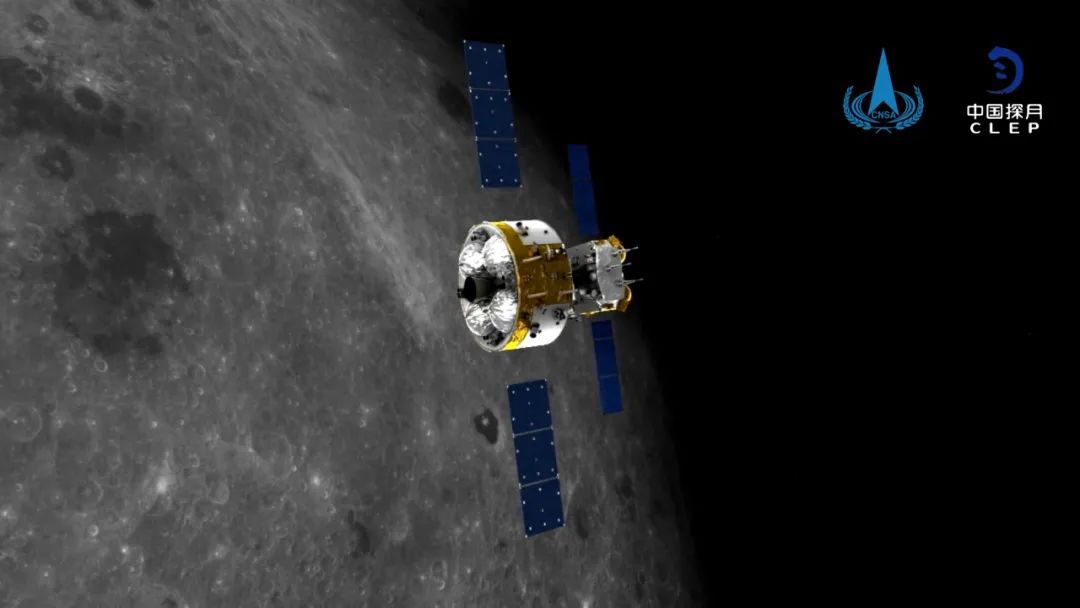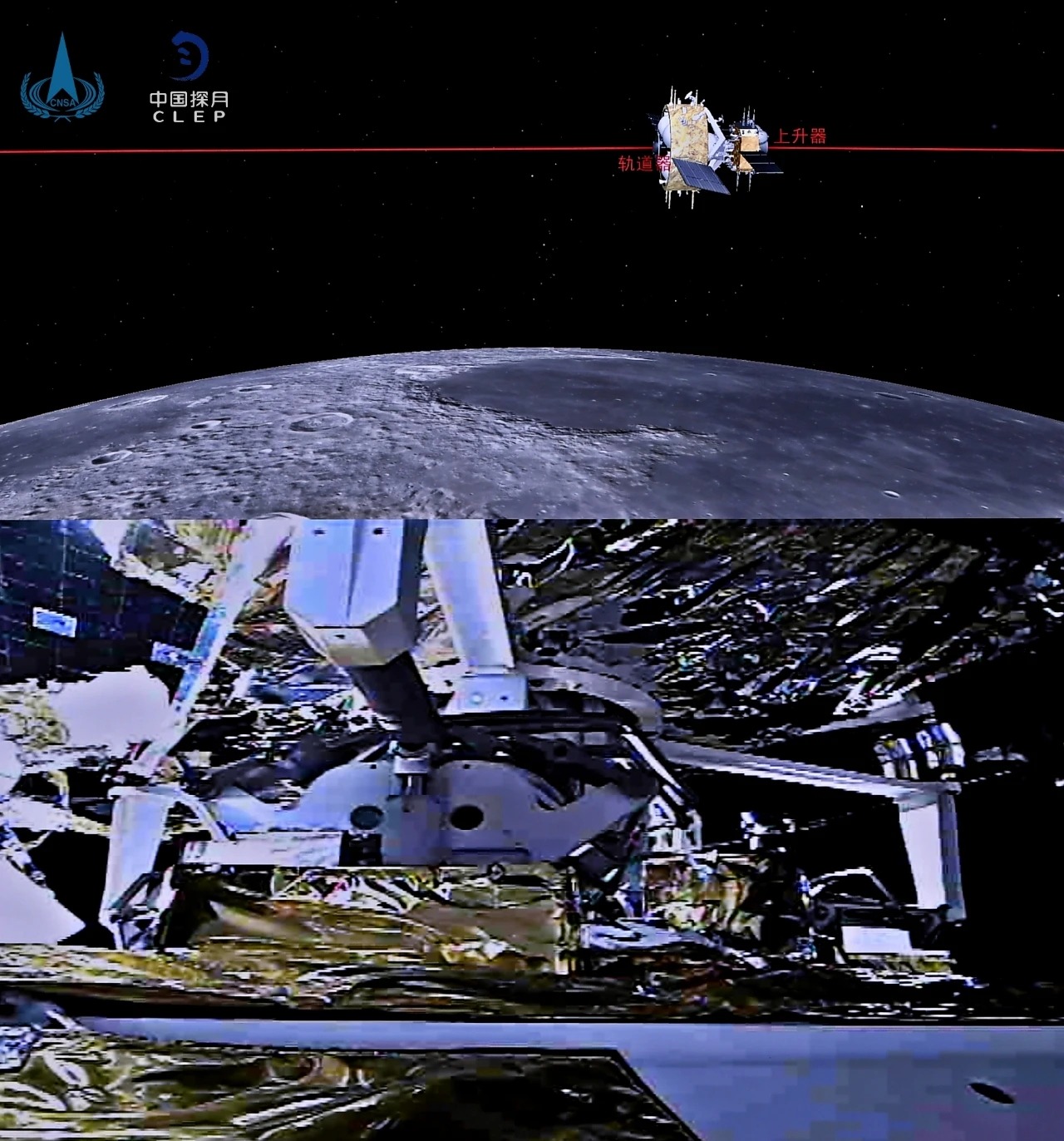China's Chang'e 5 aces lunar orbit docking needed to bring moon samples home
It's the first robotic docking around the moon in history.

Two Chinese spacecraft have successfully carried out a docking in lunar orbit to bring home the first samples from the moon in over 40 years.
The Chang'e 5 ascent vehicle and orbiter spacecraft came together Saturday (Dec. 5) at around 4:42 p.m. EST (21:42 GMT, 05:42 Dec. 6 Beijing time) to complete the first-ever robotic rendezvous and docking in lunar orbit, the China Lunar Exploration Program announced.
The success is a huge step towards China being able to deliver to Earth what are hoped to be the youngest samples ever collected from the moon, and the first since 1976. Laboratory analysis of the material could explain mysteries about the history of our nearest celestial neighbor.
Video: Watch China's Chang'e 5 mission land on the moon
China On the Moon! A History of Chinese Lunar Missions in Pictures
The four-module Chang'e 5 spacecraft launched on Nov. 23 and made China's third landing on the moon on Dec. 1. The landing craft collected around 4.4 lbs. (2 kilograms) of samples shortly after. An ascent vehicle carrying the samples then lifted from the moon on Dec. 3 and entered orbit 6 minutes later.
But to have a chance at getting the precious cargo to Earth the ascent vehicle needed to rendezvous and dock with the waiting Chang'e 5 orbiter. Such maneuvers had not been carried out robotically in lunar orbit before and was one of the new tests the mission posed to Chinese engineers.


"In terms of the space tasks that humans have performed so far, only the Apollo program missions have completed the rendezvous and docking in lunar orbit. However uncrewed rendezvous and docking have never been done before," Peng Jing, deputy chief designer of the Chang'e 5 probe from the China Academy of Space Technology (CAST), told Chinese media ahead of the attempt.
Get the Space.com Newsletter
Breaking space news, the latest updates on rocket launches, skywatching events and more!
"It will be the historic first, and it will be very difficult," Peng stated, adding that the relative position of the two spacecraft needs to be controlled to accuracy of no less than 2 inches (5 centimeters).
The operations also needed to be automated due to the time delay in communicating across the roughly 236,000 miles (380,000 kilometers) between the Earth and the moon.
Photos: Amazing panorama shows the Chang'e 5 landing site on the moon
The success is also a step forward for plans to send astronauts to the moon in the future.
"The rendezvous and docking, together with the preceding moves of landing and take-off and the subsequent move of returning, are also important parts in the manned lunar mission. It has laid a technical foundation for our future projects of deep space exploration and manned lunar mission," Liu Ran, director of the China National Space Administration's Lunar Exploration and Space Program Center told Chinese media.
Docking used a gripping mechanism on one side and a horizontal bar on the other. The samples were transferred from ascent vehicle to a reentry capsule attached to the orbiter around 30 minutes after docking. The orbiter has since jettisoned the ascent vehicle and will take the reentry capsule towards Earth on the final leg of the 23-day Chang'e 5 journey.
Related: We may be in a 'golden age' of sample-return space missions

The lunar samples won't be coming home immediately however. The Chang'e 5 orbiter will need to wait in lunar orbit for around a week for a narrow window in which to fire its engines and head for Earth.
The carefully timed trans-Earth injection maneuver will start an 112-hour journey that will allow the orbiter to deliver the reentry module to Earth at the precise time in order to land in Siziwang Banner, Inner Mongolia — the same site used by the China National Space Administration to return astronauts home aboard Shenzhou spacecraft.
Reentry and landing is expected around Dec. 17. As spacecraft returning from the moon are traveling faster than those reentering from low Earth orbit, such as trips from the International Space Station, the Chang'e 5 reentry module will bounce off the atmosphere once to help it slow down before taking a final, fiery plunge to Earth.
China tested just such a high-speed return from the moon and reentry in 2014 with the Chang’e 5 T1 test mission.
If all goes well, the sealed samples will then be transferred to specially designed laboratories for a series of radiometric, isotopic, composition and other tests to uncover evidence of their age and what they reveal about the history of the moon.
Follow us on Twitter @Spacedotcom and on Facebook.
Join our Space Forums to keep talking space on the latest missions, night sky and more! And if you have a news tip, correction or comment, let us know at: community@space.com.

Andrew is a freelance space journalist with a focus on reporting on China's rapidly growing space sector. He began writing for Space.com in 2019 and writes for SpaceNews, IEEE Spectrum, National Geographic, Sky & Telescope, New Scientist and others. Andrew first caught the space bug when, as a youngster, he saw Voyager images of other worlds in our solar system for the first time. Away from space, Andrew enjoys trail running in the forests of Finland. You can follow him on Twitter @AJ_FI.








